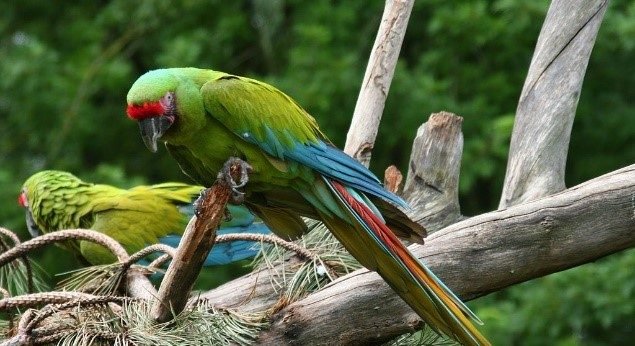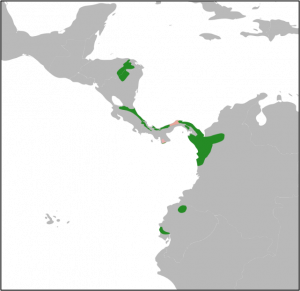Green Macaws

GREEN MACAWS
My recent blog introduced the readers to the Scarlett Macaw. Today I will talk about Costa Rica’s other Macaw specie, much rarer and much more limited in range but equally magnificent – the aptly named Great Green Macaw, or Ara Ambiguus.

WHAT DO GREEN MACAWS LOOK LIKE?
As the name suggest, Great Green Macaws are predominantly green in plumage, except for a red forehead, blue wing tips, upper back and lower tail feathers, and a brownish-red tail tipped with blue feathers. These are large birds, about 90 cm in length, a bit longer and heavier than the Scarlett Macaw – the Great Green Macaw is, in fact, the second biggest parrot in the world.
WHERE CAN I SEE GREEN MACAWS IN COSTA RICA?
Green Macaws can be found in a narrow belt running along the Caribbean shore and northern border areas of Costa Rica. They prefer the high canopies of humid and wet lowland tropical forests. The current range of these birds represent just 10% of its historical range in Costa Rica – a huge reduction. The best places for catching a glimpse of these birds are in the north-eastern corner of the country and along the border with Nicaragua, eg. Tortuguero National Park, Refugio Nacional de Vida Silvestre Barra del Colorado, Barra del Colorado Wildlife Refuge, and Sarapiqui. A seasonal population also exists inland in Braulio Carrillo National Park. In the south-eastern tip of Costa Rica, the Gandoca – Manzanillo National Refuge is home to a Green Macaw breeding program release station called ‘Ara Manzanillo’ (https://aramanzanillo.org/about/background/).

ARE GREEN MACAWS IN TROUBLE?
While Scarlett Macaws are not in danger of extinction and are relatively widespread across their range, Green Macaws do not share this rosy fate. They are critically endangered and very rare in Cost Rica and across all of their current range, which is confined to isolated areas of Nicaragua, Honduras, Costa Rica, Panama, Colombia, and Ecuador. It is estimated that fewer than 200 of these birds live in Costa Rica, with a total global population of perhaps 2500-3000 Green Macaws, but potentially as low as 500-1000. There is obviously much uncertainty about these numbers, but any way you look at it – these birds are in trouble.
WHY ARE GREEN MACAWS FACING SUCH AN UNCERTAIN FUTURE?
Green Macaws have a special affinity for the Mountain Almond tree – not only utilizing its fruit seeds as a main source of food but also choosing it as a favorite nesting location – over 90% of Costa Rica’s Green Macaw nests have been found high up in the safety of natural cavities inside Mountain Almonds. Unfortunately for the birds this particular tree is prized for its lumber, being very hard (one of the hardest trees in the world) and thus durable and termite-resistant. Mountain Almonds have not been logged until the mid-1980s when special carbon steel and diamond tipped chainsaw blades were developed to cope with their ultra-tough wood, the heavy lumber soon becoming a favorite material for construction of hardy structures like railroad components and bridges as well as high impact sporting equipment. Thus in a few short decades the tree has been logged heavily, uncontrollably and relentlessly until 2008 when harvesting of the Mountain Almond was banned as both the tree and the Green Macaws were well on their way to extinction in Costa Rica.

Another culprit in the crisis is deforestation – over the past few generations huge swaths of Green Macaws’ favorite old growth coastal rainforests have been cleared to make way for pineapple and banana plantations – of course thus destroying more of the tall trees that provided them shelter, food and protection. This was a result of Costa Rica’s aggressive agriculture development policy which decimated the forests between the 19950s and 1990s – thankfully the picture has now reversed with reforestation efforts being front of the agenda and wide-ranging logging controls and bans being in place since 1996.
It is interesting to note that the Beach Almond tree, introduced to Costa Rica around the turn of the last century and since then becoming widespread and common, has become a favourite food of the Scarlett Macaw helping these birds deal with the pressures of deforestation and pet trade. Green Macaws, however, never took to the Beach Almond (not a true almond, by the way) but to this day continue their daily trips into the hills in search of their favourite Mountain Almond trees – although recently reports indicate they have started to sample Beach Almond fruit, which is a very encouraging sign.
But the damage has been done, and now both the Mountain Almond tree and the parrot are endangered in Costa Rica.

SO WHAT HAPPENS NOW?
The Green Macaw has become a potent symbol of conservation and preservation across Costa Rica. People come from all over the world to catch a glimpse of these unique birds – which is great for the Macaws. The government of Costa Rica, together with private lodges and businesses, conservation associations and non-profit organisations are doing amazing work to reverse the decline of the Green Macaws. Breeding and repopulation programs together with efforts to plant Mountain Almond trees are beginning to make a big difference.
HOW CAN I HELP?
The best way to help is to financially support efforts to replant and protect the Mountain Almonds and ongoing breeding and release programs. Many of the organizations working to help Green Macaws accept donations. If you are in Costa Rica, you can take part in the planting of Mountain Almond trees or volunteer with a breeding program organization. If you are not here you can send donations or ‘adopt’ a living Mountain Almond tree. Another way to help is to support businesses which ‘make their living’ from Green Macaws – lodges, tour companies, and the businesses located near Green Macaw habitats, for example the National Parks and Wildlife Refuges mentioned earlier in this article.
See the links below to help out and find more information – this list is not exhaustive, so have a google search form more organisations that help Green Macaws in Costa Rica.
https://macawconservation.org/
https://macawrecoverynetwork.org/
Costa Rica is a green destination proud of the wildlife and nature contained within her bounds, with 28% of the land officially protected and ongoing programs to restore lost natural areas and wildlife showing great success. Very few countries share this vision and results – in fact many are moving in the opposite direction. Costa Rica is head above shoulders of the neighboring nations in many areas including stewardship of nature and environmental efforts – is that not a huge reason for choosing to move here? Visit the RE/MAX We Sell Paradise to meet your trusted real estate partners or view the hot properties in our local area.



